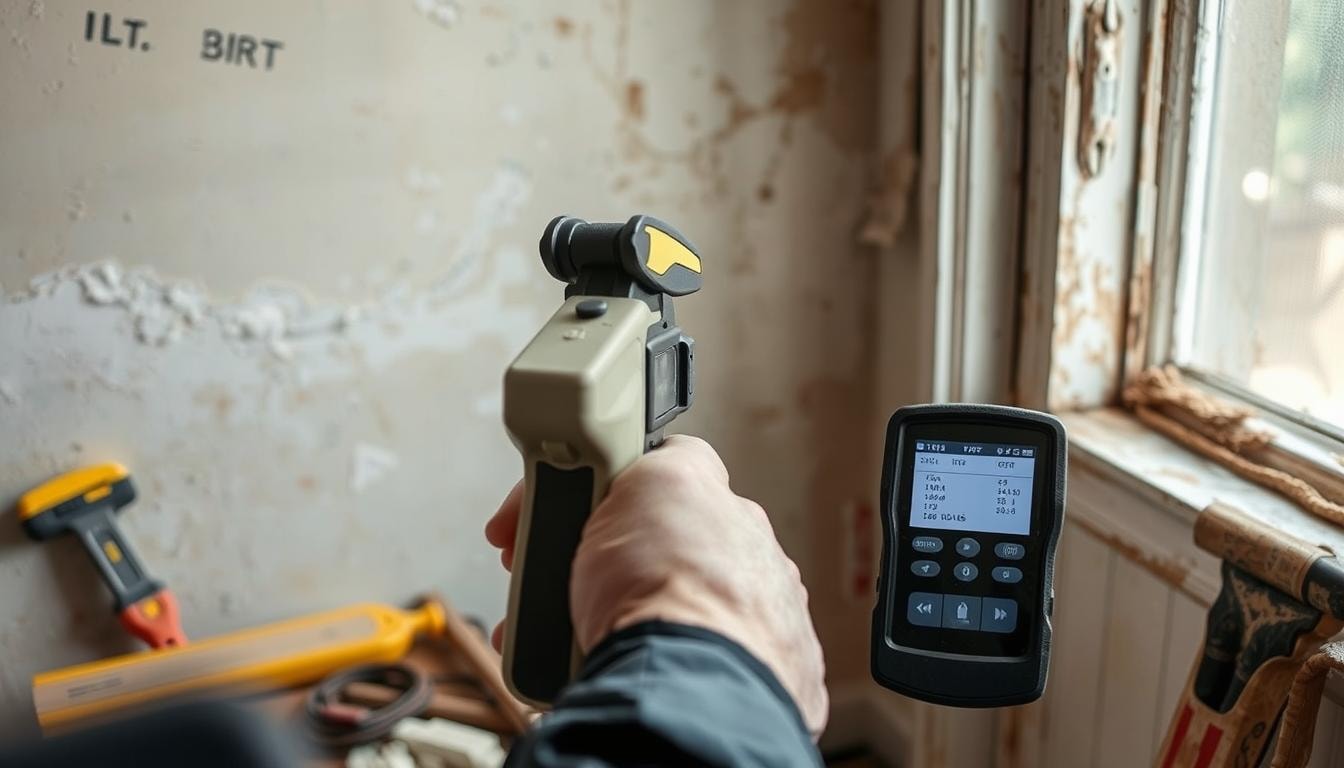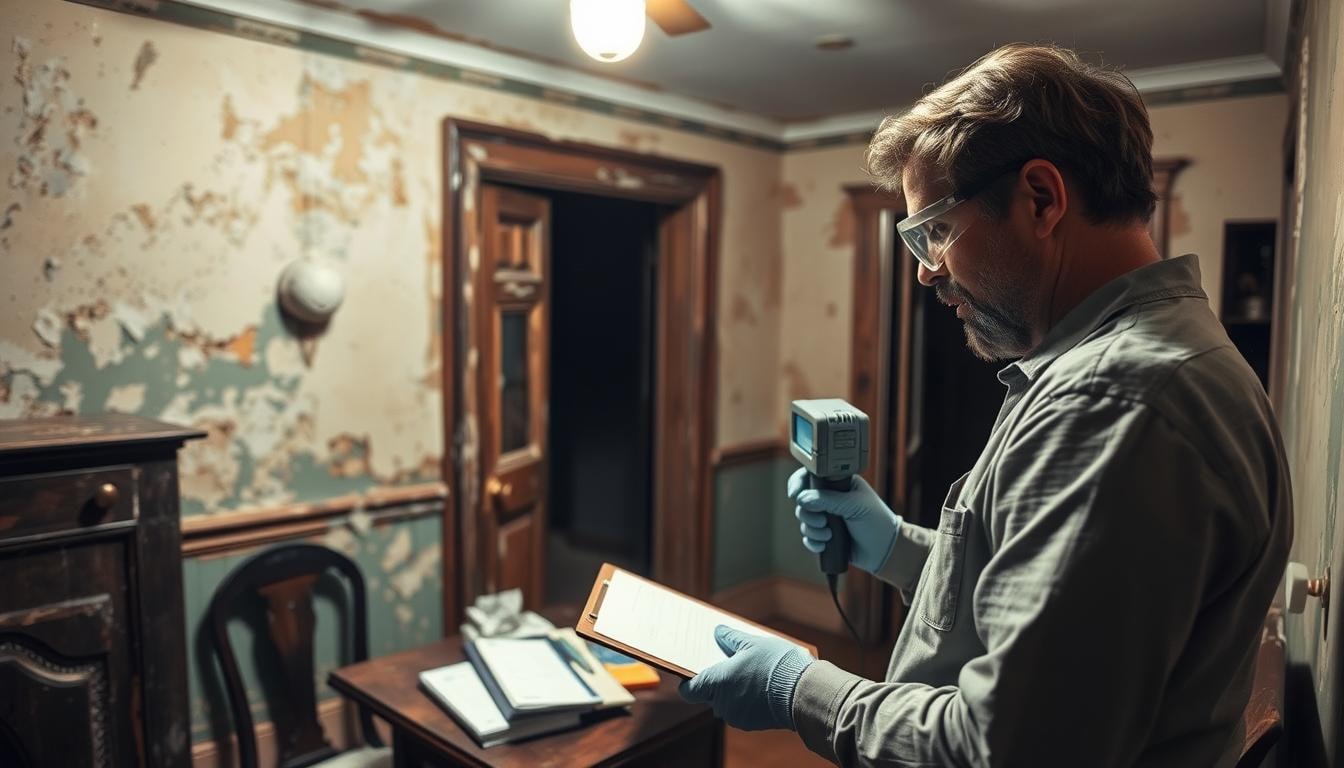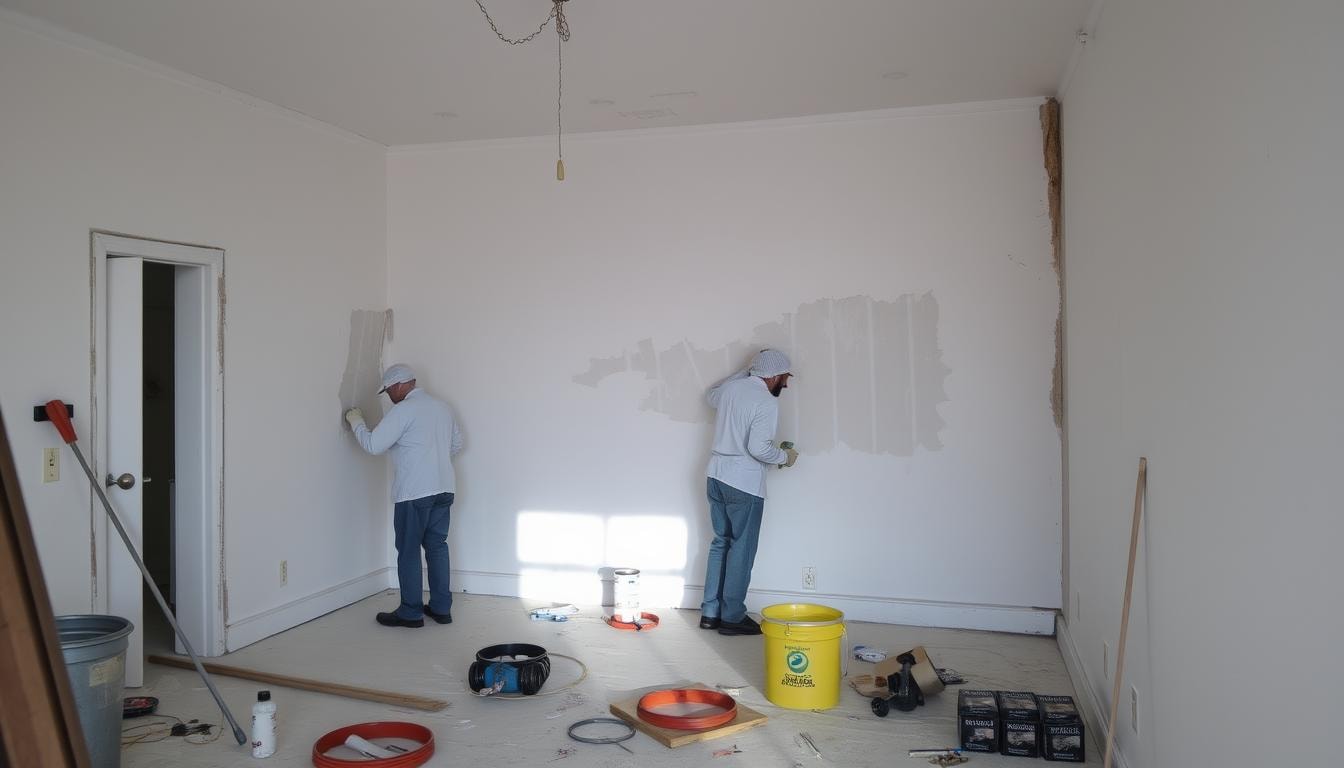Lead Paint Inspection Near You
Can’t find what you are looking for?
How It Works
-
Answer a few questions about your home project.
-
Within seconds, get matched with top-rated local pros.
-
Compare quotes and choose the best pro for the job.
Lead Paint Inspection In Your Area
Need a Lead Paint Inspection? Here’s What to Expect
Meta Description: Discover what to expect during a lead paint inspection. Learn about the process, potential hazards, and how to ensure your home is safe from lead-based paint risks.

Identifying lead-based paint in your home is crucial for your family’s health and safety. Lead paint inspections are vital due to its harmful effects on physical and mental well-being. Let’s explore what this process involves and why it’s so important.
Lead-based paint was widely used in homes before 1978 when the U.S. government banned it. Many older properties still contain this toxic substance. It can flake, chip, or deteriorate over time.
When disturbed, lead paint particles can contaminate the environment. This puts occupants, especially young children, at risk of exposure and potential lead poisoning.
Key Takeaways
-
01
Lead-based paint was widely used in homes before it was banned in 1978, and many older properties still contain this hazardous material.
-
02
A professional lead paint inspection can identify the presence, location, and condition of lead-based paint in your home, as well as any lead dust or soil contamination.
-
03
Hiring a certified lead inspector is crucial to ensure the safety and accuracy of the inspection process.
-
04
The inspection process involves a thorough examination of the property and may use X-Ray Fluorescence (XRF) analysis to detect lead levels.
-
05
Knowing the results of a lead paint inspection can help you make informed decisions about addressing potential lead hazards and protecting your family’s health.
Understanding the Dangers of Lead-Based Paint
Lead exposure from lead-based paint can cause severe, irreversible harm, especially to young children. Kids under 6 are most at risk due to their rapid growth and development. Their hand-to-mouth behavior and higher lead absorption rate increase the danger.
Lead Exposure Risks for Children
Lead can cause many health problems in children. These include developmental delays, learning difficulties, and irritability. Other issues are weight loss, fatigue, abdominal pain, and vomiting.
Hearing loss and seizures can also occur. No safe level of lead exposure has been found for children.
Health Consequences of Lead Poisoning
Lead-based paint, often found in pre-1978 homes, is a major source of lead exposure. It can release lead dust, which children might ingest while playing or touching contaminated objects.
Addressing lead-based paint hazards at home is vital to protect children and vulnerable individuals. It’s crucial for ensuring their health and well-being.
About 29 million U.S. homes have lead-based paint hazards. Young children live in 2.6 million of these houses. Homeowners should be alert to identify and address lead-based paint risks.
When Is a Lead Paint Inspection Necessary?
Homes built before 1978 need a professional lead paint inspection. Lead-based paint was common then and can be dangerous, especially for kids. Look for cracked, peeling, or chalky paint on surfaces like doors and windows.
Planning renovations in a pre-1978 home? Get an inspection first. Disturbing lead paint can release harmful dust into the air. This puts your family at risk of lead poisoning.
If you or your child show signs of lead exposure, get an inspection. It can help find the source and guide next steps.
Signs of Lead Paint in the Home
- Cracked, peeling, or chalky paint on doors, windows, stairs, porches, railings, and banisters
- Homes built before 1978, when lead-based paint was still commonly used
- Planned renovation or repair work in a pre-1978 home
- Symptoms of lead poisoning in you or your child
Even homes built after 1978 might have lead-based paint. The risk is lower, but a professional inspection can still help. They’ll check for any lead-based paint hazards.
Lead Paint Inspection vs. Risk Assessment

Lead paint inspections and lead risk assessments are vital for evaluating lead-based paint in homes. These processes have different purposes and provide unique insights.
A lead paint inspection examines property surfaces to find lead-based paint. It identifies the presence and location of lead paint, regardless of its condition.
A lead risk assessment goes deeper by investigating lead hazards in paint, dust, and soil. It determines the locations, severity, and types of lead hazards.
Risk assessors also provide recommendations for remediation. This helps homeowners address lead hazards effectively.
Combining both processes gives a full picture of lead-based paint issues. It helps homeowners understand the problem and find effective solutions.
The choice between inspection and assessment depends on the homeowner’s needs. Both help identify and address lead-based paint concerns.
The Lead Paint Inspection Process
Lead paint inspections are vital for finding hazards in homes. Certified inspectors use special tools to check for lead-based paint. This helps protect people, especially kids, from harmful lead exposure.
Inspectors look closely at high-traffic areas in the house. These include doors, windows, stairs, and railings. These spots often have worn paint that can be dangerous.
They also check outside areas like porches and siding. The soil around the house may be tested too.
What Inspectors Look For
Inspectors focus on surfaces that get a lot of use. They pay attention to places where paint might chip or peel. This is where lead paint can be most harmful.
Testing Methods
The main test used is X-Ray Fluorescence (XRF) analysis. It uses a handheld device to find lead in paint without damaging walls. This method gives quick, accurate results.
Inspectors carefully record everything they find. They make a detailed report about any lead paint hazards they discover.
Hiring a Certified Lead Paint Inspector
Certified lead paint inspectors are vital for evaluating lead-based paint hazards in homes. They have the training and equipment to conduct safe, accurate inspections. The EPA or authorized state programs must certify these professionals.
These experts know EPA regulations for lead-based paint identification and testing. They use specialized tools like XRF analyzers for reliable results. Their precautions minimize lead exposure risks during inspections.
Hiring a certified inspector ensures a thorough, compliant evaluation of your home. They provide crucial information to address lead-based paint hazards effectively.
- Certified lead paint inspectors are trained and authorized to conduct lead-based paint inspections.
- They use specialized equipment like the XRF analyzer to ensure accurate and reliable testing results.
- Certified inspectors follow the EPA’s strict guidelines for lead-based paint identification, testing, and reporting.
- Hiring a certified lead inspector ensures the inspection process is safe, comprehensive, and provides the necessary information to address lead hazards.
A certified lead paint inspector’s expertise is key to your home’s safety. Their services help you tackle lead-based paint risks. This protects your family from harmful lead exposure effects.
Next Steps After a Lead Paint Inspection

After a lead paint inspection, it’s crucial to address any identified hazards. If deteriorating lead-based paint is found, lead abatement becomes necessary.
Lead abatement permanently removes, encapsulates, or encloses lead-containing materials to eliminate exposure risk. Certified lead abatement contractors must perform this work using lead-safe work practices.
Lead Abatement Options
Several lead abatement or remediation approaches can be considered based on the inspection results. These options depend on the extent of lead paint hazards.
- Permanent lead paint removal through chemical, thermal, or mechanical methods
- Lead paint encapsulation using specialized coatings to seal and contain the hazard
- Lead paint enclosure by covering the affected surfaces with drywall, paneling, or other barriers
- Lead paint containment through methods like paint stabilization and interim controls
Lead-based paint in good condition may be managed in place through encapsulation. A certified lead inspector or risk assessor will recommend the best approach.
Lead-Safe Renovation and Repair Practices
Lead-based paint in homes requires lead-safe work practices during renovation, repair, or painting projects. Disturbing lead paint can release harmful dust into the air. EPA rules require contractors working on pre-1978 homes to be certified in lead-safe practices.
Specialized equipment and techniques are used to contain work areas and minimize dust. Proper disposal of lead-contaminated waste is essential. DIY homeowners should take precautions like using HEPA vacuums and wearing protective gear.
Thorough cleaning of the work area afterwards is crucial. These practices protect your family’s health during home projects.
In 2010, Oregon’s Construction Contractors Board and Health Authority took over EPA’s rule enforcement. The rule applies to pre-1978 homes and child-occupied facilities. It requires training and certification for individuals and firms doing renovation work.
Agencies and businesses without CCB licenses need OHA certification. They must use OHA-trained renovators. This rule affects contractors, painters, landlords, and maintenance workers.
Protecting Your Family from Lead Hazards
Safeguarding your loved ones from lead-based paint risks requires a thorough approach. If your home inspection finds lead paint in good condition, encapsulation may work. This creates a barrier to prevent lead paint from generating hazardous dust.
For renovations involving lead paint, strict precautions are crucial. Hire certified contractors trained in lead-safe work practices. Contain the work area and use HEPA vacuums for thorough cleaning.
Regularly inspect painted surfaces for signs of deterioration. Address any issues promptly to minimize lead exposure risks.
Encapsulation and Renovation Precautions
Take proactive steps to identify and control lead hazards. This may involve lead paint encapsulation, containment, and following safety protocols. These measures help during lead paint renovation or remodeling projects.
- Hire certified contractors trained in lead-safe work practices for any renovations or repairs involving lead paint.
- Contain the work area to prevent the spread of lead dust and use HEPA vacuums to clean up thoroughly.
- Regularly inspect painted surfaces for signs of lead paint deterioration and address issues promptly.
- Consider lead paint encapsulation as a long-term solution to prevent lead exposure from stable, intact lead paint.
By taking these steps, you can effectively minimize lead hazards. This helps protect your family’s health from lead-based paint dangers.
Find the Right Pros for Lead Paint Inspections and Deleading Work
Dealing with lead-based paint in your home can be a serious issue that requires expert attention. Whether you need a comprehensive lead paint inspection or are planning renovation, repair, and painting work, finding the right professionals is crucial. That’s where FindPros can help.
By answering a few simple questions about your home and the project at hand, FindPros can match you with top-rated local pros who specialize in lead-based paint inspections and deleading work. You’ll get the best pricing when multiple pros compete for your job, and you can compare quotes to find the perfect fit. Take the first step towards a safe, lead-free home – contact FindPros today.
Conclusion
Lead-based paint is a serious health risk, especially for young children. A professional lead paint inspection can identify its presence in your home. This allows you to take steps to reduce the dangers.
You can control lead paint hazards through encapsulation or lead-safe renovations. Full abatement is another option. Taking action is vital to protect your family’s health.
Understanding lead paint risks and following safety practices ensures a healthy home. Addressing lead-based paint issues is crucial for long-term lead paint exposure prevention. Stay informed about lead paint awareness and regulations to protect your loved ones.
Lead paint testing provides key information for managing hazards effectively. Work with certified pros and follow thorough inspection methods. This helps create a safer home for everyone.
Frequently Asked Questions (Lead Paint Inspection)
MOST POPULAR CITIES
Browse by State- Alameda
- Costa Mesa
- Laguna Beach
- Orange
- Alhambra
- Culver City
- Lancaster
- Oroville
- Anaheim
- Daly City
- Livermore
- Oxnard
- Antioch
- Davis
- Lodi
- Pacific Grove
- Arcadia
- Downey
- Lompoc
- Palm Springs
- Bakersfield
- El Centro
- Long Beach
- Palmdale
- Barstow
- El Cerrito
- Los Angeles
- Palo Alto
- Belmont
- El Monte
- Malibu
- Pasadena
- Berkeley
- Escondido
- Martinez
- Petaluma
- Beverly Hills
- Eureka
- Marysville
- Pomona
- Brea
- Fairfield
- Menlo Park
- Port Hueneme
- Buena Park
- Fontana
- Merced
- Rancho Cucamonga
- Burbank
- Fremont
- Modesto
- Red Bluff
- Calexico
- Fresno
- Monterey
- Redding
- Calistoga
- Fullerton
- Mountain View
- Redlands
- Carlsbad
- Garden Grove
- Napa
- Redondo Beach
- Carmel
- Glendale
- Needles
- Redwood City
- Chico
- Hayward
- Newport Beach
- Richmond
- Chula Vista
- Hollywood
- Norwalk
- Riverside
- Claremont
- Huntington Beach
- Novato
- Roseville
- Compton
- Indio
- Oakland
- Sacramento
- Concord
- Inglewood
- Oceanside
- Salinas
- Corona
- Irvine
- Ojai
- San Bernardino
- Coronado
- La Habra
- Ontario
- San Clemente